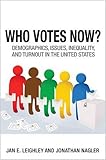Who Votes Now? : Demographics, Issues, Inequality, and Turnout in the United States / Jan E. Leighley, Jonathan Nagler.
Material type: TextPublisher: Princeton, NJ : Princeton University Press, [2013]Copyright date: ©2014Edition: Course BookDescription: 1 online resource (232 p.) : 44 line illus. 26 tablesContent type:
TextPublisher: Princeton, NJ : Princeton University Press, [2013]Copyright date: ©2014Edition: Course BookDescription: 1 online resource (232 p.) : 44 line illus. 26 tablesContent type: - 9780691159348
- 9781400848621
- Elections -- United States -- Statistics
- Elections -- United States -- Statistics
- Political participation -- United States -- Statistics
- Political participation -- United States -- Statistics
- Voter turnout -- United States -- Statistics
- Voter turnout -- United States -- Statistics
- POLITICAL SCIENCE / American Government / General
- American National Election Studies
- Current Population Survey
- U.S presidential elections
- U.S. Census Bureau
- U.S. presidential elections
- absentee voting
- conditional relationships
- demographics
- election laws
- election reform
- electoral reforms
- electorate
- electrion law
- income bias
- inequality
- nonvoters
- policy choices
- policy positions
- redistributive issues
- representation
- state electoral rules
- voter behavior
- voter registration laws
- voter registration
- voter representation
- voter turnout
- voting
- 324.973 23
- JK1967 .L45 2017
- online - DeGruyter
- Issued also in print.
| Item type | Current library | Call number | URL | Status | Notes | Barcode | |
|---|---|---|---|---|---|---|---|
 eBook
eBook
|
Biblioteca "Angelicum" Pont. Univ. S.Tommaso d'Aquino Nuvola online | online - DeGruyter (Browse shelf(Opens below)) | Online access | Not for loan (Accesso limitato) | Accesso per gli utenti autorizzati / Access for authorized users | (dgr)9781400848621 |
Frontmatter -- Contents -- List of Figures -- List of Tables -- Preface -- Acknowledgments -- One. Introduction -- Two. Demographics of Turnout -- Three. Theoretical Framework and Models -- Four. The Legal Context of Turnout -- Five. Policy Choices and Turnout -- Six. On the Representativeness of Voters -- Seven. Conclusion -- References -- Index
restricted access online access with authorization star
http://purl.org/coar/access_right/c_16ec
Who Votes Now? compares the demographic characteristics and political views of voters and nonvoters in American presidential elections since 1972 and examines how electoral reforms and the choices offered by candidates influence voter turnout. Drawing on a wealth of data from the U.S. Census Bureau's Current Population Survey and the American National Election Studies, Jan Leighley and Jonathan Nagler demonstrate that the rich have consistently voted more than the poor for the past four decades, and that voters are substantially more conservative in their economic views than nonvoters. They find that women are now more likely to vote than men, that the gap in voting rates between blacks and whites has largely disappeared, and that older Americans continue to vote more than younger Americans. Leighley and Nagler also show how electoral reforms such as Election Day voter registration and absentee voting have boosted voter turnout, and how turnout would also rise if parties offered more distinct choices. Providing the most systematic analysis available of modern voter turnout, Who Votes Now? reveals that persistent class bias in turnout has enduring political consequences, and that it really does matter who votes and who doesn't.
Issued also in print.
Mode of access: Internet via World Wide Web.
In English.
Description based on online resource; title from PDF title page (publisher's Web site, viewed 30. Aug 2021)


